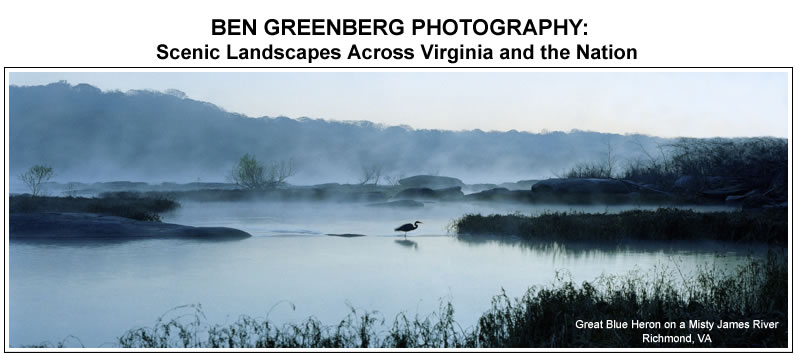 |
|
|
Click your mouse on the questions below to view the answers:
Why do you only use metal frames and are your photographs and all your materials archival?
It is very important to me that my photographs and all materials involved in their preparation and presentation be archival. I want my photographs to last 100 years or more with no ill effects over time. It is important that the materials used be archival and acid free. Metal frames meet this requirement, as they are inert and will not interact with the museum quality mat board used or the specially prepared prints with the newest K3 pigmented inks. Unfortunately, wood frames are not archival and will eventually discolor the mat and/or the print, so I do not use them. Metal frames will never do this, so when a photograph is purchased, one can hang it with confidence that it will retain its natural beauty for a lifetime of enjoyment. I also believe that metal frames are the perfect contemporary method to present landscape photographs, complementing the image and never competing with it.
Is there anything else I can do to help preserve the beauty of the phtotograph?
There are several conditions that can damage
photographs (and almost all art work,
although most artists don’t
mention them) over time: sunlight, heat and humidity. One should
never hang a photograph in direct sunlight for extended periods
of time. Nor should a photograph be placed in a location that is
subject to heat and humidity for protracted periods. These conditions
will cause discoloration and/or fading. It is important to point
out, however, that some materials are more resistant to discoloration
and fading than others, and images printed by Ben Greenberg Photography
meet the highest quality standards and resist the impact of such
conditions.
How do you obtain such vivid colors in your color photographs?
There are several answers to this important question. First, I love saturated colors in nature and I love them even more when my images reflect this standard of mine. I have been searching for and photographing natural scenes for more than thirty five years and during that time I have been fortunate to discover and photograph locations that meet this expectation and goal of mine. These are the images that I print and exhibit for the public. Second, I use films such as those made by Fuji that are known for their color quality and intensity. Third, I take a large majority of my photographs at the time of day when sun is the lowest and, therefore, the light is most directional and warm. These times are at sunrise and shortly thereafter and before sunset. Fourth, I make great effort to visit locations when they are at peak color, such as during the Spring or Fall. I often visit such locations many times until I have the opportunity to capture an image that is very special. Fifth, I use the newest technology in printing my images so that the color I capture on film is reflected vividly in my archival prints.
Why don’t you make limited editions of your images?
Photographers and other artists make limited editions of their prints in an effort to create artificial scarcity and therefore justify selling them at increased prices. I do not agree with this approach. I sell my photographs at a fair price that allows more people the opportunity to purchase and enjoy them. It is important to point out that the so called limited editions of many photographers reflect very large numbers of potential prints, such as 600 or even 900, numbers that will likely never be sold of that particular image; therefore, it is a limited edition in name only. I wonder how such photographers count the different sizes in which they sell their images. Do the numbers include all the sizes they make? I also wonder how one will ever truly know if the photographs are printed in accordance with the stated limited edition. Finally, I would like to point out that perhaps the greatest photographer of all time, Ansel Adams, sold more than 900 prints of his photograph entitled “Moonrise over Hernandez” during his lifetime and he never created limited editions of his photographs. If it is good enough for Ansel Adams not to number his prints, it is good enough for me.
Ben Greenberg Photography • Charlottesville, VA. 22902 • • cell - 804.467.8212 • |
©
Copyright Ben Greenberg. All rights reserved |
| Copyright for these photographs belong solely to Ben Greenberg. Images may not be copied, downloaded or used in any way without the expressed written permission of the photographer. |